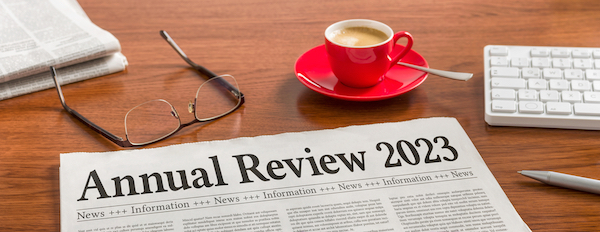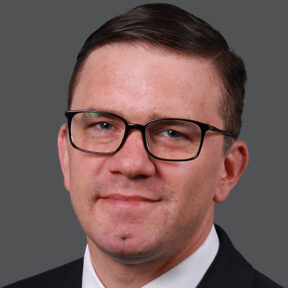“A practitioner can only hope that if these new rules are even partially effective, there will be a noticeable increase in efficiency for all parties involved.”
 The U.S. Patent and Trademark Office’s (USPTO’s) 2023 has been one marked by a push towards further modernization and reduction of environmental impact, while also attempting to increase administrative efficiency. The Office has also solicited and received zealous commentary from an interested public regarding proposed changes to Patent Trial and Appeals Board (PTAB) proceedings. Lastly, in continuation of last year’s prevailing theme, the USPTO has begun generating reports, holding listening sessions, and publishing Director’s blogs regarding the topic of artificial intelligence (AI) as it pertains to both inventorship and as a subject of invention.
The U.S. Patent and Trademark Office’s (USPTO’s) 2023 has been one marked by a push towards further modernization and reduction of environmental impact, while also attempting to increase administrative efficiency. The Office has also solicited and received zealous commentary from an interested public regarding proposed changes to Patent Trial and Appeals Board (PTAB) proceedings. Lastly, in continuation of last year’s prevailing theme, the USPTO has begun generating reports, holding listening sessions, and publishing Director’s blogs regarding the topic of artificial intelligence (AI) as it pertains to both inventorship and as a subject of invention.
Modernization, Reduction of Waste, and Lowering the Financial Bar for Small Entities
Through a series of new final rules that have gone into effect in 2023, the USPTO has attempted to increase the Office’s administrative efficiency by moving further into the digital era. First, the Office switched to an all-electronic patent grant system (88 FR 12560). This new rule created a new form known as the Electronic Patent Grant Information sheet (EPGI). The EPGI sheet contains key patent grant data, such as the patent number, title, filing date, and the names of the patentee and inventors. The EPGI sheet is incorporated into the electronic patent grant file, ensuring easy access for future reference. The USPTO hopes to become more environmentally conscious by “foster[ing] a green economy,” and reducing the latency period between the time of issuance and publication. Gone are the days when an inventor can obtain the cathartic satisfaction of holding a signed, sealed, and delivered notice of issuance and the accompanying ceremonial patent copy.
Second, the USPTO has promulgated a pair of new rules requiring that all applications related to patent term extensions (PTEs), and Patent Term Adjustment Statements (PTAs) responding to Information Disclosure Statements be filed electronically, using the correct document code (88 FR 13028 and 88 FR 39172, respectively). The Office expects that both of these new rules will significantly cut down on paper waste, while also increasing the Office’s administrative efficiency by receiving these filings in a manner that meets USPTO filing guidelines in both form and substance. Another expected benefit of the PTE final rule is increased transparency on the status of a filed PTE for both the practitioner and the client.
Lastly, the USPTO has sought to increase the availability of IP protection in a more equitable manner by changing the fee structures for small and micro-entities pursuant to the Unleashing American Innovators Act of 2022 (UAIA) (88 FR 17147). The UAIA prescribes a reduction in fees of 50-60% for certain small entities, and fee discounts of 75-80% of micro entities in “filing, searching, examining, issuing, appealing, and maintaining patent applications and patents.” Furthermore, small entities may have their filing fees reduced by 75-80% for basic, nonprovisional utility applications. Conversely, the Office has promulgated a final rule that anticipates increasing fees for large entities beginning with applications filed on or before January 17, 2024 (88 FR 36956 citing to 85FR 46932).
It is worth noting that some aspects of these new rules have not been without detractors, as IPWatchdog reported in November.
A Raucous RFC
On April 21, 2023, the USPTO published an Advanced Notice of Proposed Rulemaking (ANPRM) in the Federal Register (88 FR 24503). That ANPRM, titled “Changes Under Consideration to Discretionary Institution Practices, Petition Word-Count Limits, and Settlement Practices for America Invents Act Trial Proceedings Before the Patent Trial and Appeal Board,” was met with an interesting array of responses, many having particular zeal. In total there were 3,436 comments provided on regulations.gov. Many comments were in opposition to the proposed rules focus on proposed changes to discretionary institution practices, particularly changes honing the ability of administrative patent judges APJs to refuse the institution of a petition based on the status of the petitioner or the patent holder. In light of similar fervor and opposition being seen in the Office’s 2022 RFC pertaining to the scope and standard of the director’s ability to review PTAB board decisions, the reaction to the currently proposed rules should not come as a shock. However, it is worth noting that the ANPRM published in 2023 has caught the attention of a broader audience in an opinion piece advocating for the opposition to the rulemaking. The author of that opinion piece is of the belief that the proposed new rules would impose almost a de facto standing requirement, thus reducing the ability of “non-interested” parties to challenge patents held by non-practicing entities.
While the ANPRM certainly has detractors, it also seems to have an equal number of proponents. The majority of the proponents of the ANPRM refer favorably to the ability of PTAB judges to discretionarily deny the institution of a petition when the petition challenges an under-resourced patentee (those filing with small or micro-entity status at the time of issuance), particularly if that entity is in the process of commercializing that patented product. Advocates of this rule point to the discrepancy in resources between small or micro-entities and large entities. They further voice concern about the ability of those larger entities to financially fund attacks on patent validity, while pointing out the inability of the smaller entities to adequately defend against the attack. This perspective seems to be more in line with the UAIA and the Office’s most recent final rules. It will be interesting to see how the rules found in the ANPRM are changed or balanced by the USPTO in subsequent iterations in order to square the prevailing interests of spurring innovation by smaller entities with the more “traditional notions” of PTAB proceedings instituted by the America Invents Act (AIA).
An Intelligently Artificial Holding Pattern
What is clear from 2023 is that AI issues at the USPTO certainly are not going anywhere soon. On October 30, 2023, President Biden issued an executive order in part directing the USPTO to provide guidance on the issues of AI inventorship and AI as patentable subject matter. Much to the USPTO’s credit, the Office has been diligently working on the issue by requesting public comments as far back as 2019. Additionally, the Office has held two “AI Inventorship Listening Sessions” and four meetings of a public-private AI/ET (Emerging Technology) Partnership instituted by the USPTO, where thought leaders from both sectors explore relevant patent issues. Yet, the inventor side of the equation is not the only one utilizing AI-based technology to assist them in their duties. Beginning in 2021, the USPTO started testing different AI platforms; however, in 2023 it appears that the Office has officially started using AI technology to assist in patent examination. For those practitioners who might want to have the same tools available to them as the examiners, Director Vidal has stated the office is “assessing approaches for making these AI search tools publicly available.”
For almost four years now, the USPTO has been working to measure, assess, and publicly discuss the issues AI presents to the patent space, in particular. Importantly, the Office has waited patiently in a “holding pattern” of sorts such that it could collect the data points required to make sound and reasoned policy decisions. Nevertheless, it appears that this current “holding pattern” will be broken by President Biden’s executive order. While it may not be the policy reveal we have all been waiting for, we should soon see a glimpse of USPTO policy resulting from the past few years of work on AI.
What’s to Come
In recent history, looking forward into the year to come has been a bit of a mixed bag. Yet, after reviewing the USPTO’s year in 2023, looking forward into 2024 is a cause for excitement, or at least intellectual intrigue. We have seen that the Office has spent the year promulgating new rules aimed at increasing efficiency while, at the same time, decreasing waste and increasing access to IP protection to smaller entities and individuals. A practitioner can only hope that if these new rules are even partially effective, there will be a noticeable increase in efficiency for all parties involved. Moving forward into 2024, the policies underlying the newly implemented rules surrounding fee adjustments – namely, increased access to IP protection – will be center stage.
It will be interesting to see how the USPTO handles the notice and comment rulemaking process regarding the ANPRM released at 88 FR 24503, the proposed PTAB changes. In particular, the evolution of the wording of the proposed rules on factors a PTAB administrative judge should consider when evaluating whether or not to exercise their discretion and refuse to institute a petition. Practitioners at the PTAB may want to be particularly keen on tracking phrases in those factors that either allude to, or explicitly mention a party’s characteristics (i.e., entity size, business model, commercialization status, etc.), as this type of language appears to be the focal point of debate.
Lastly, 2024 will be an exciting year for those who have been waiting for official guidance from the USPTO on key topics like AI inventorship and patentability. If followed as directed, the USPTO should be publishing guidance on those topics around February of 2024. Yet, that guidance will undoubtably inspire more questions than it provides answers. For instance, what type of definiteness considerations are appropriate for claims directed towards the use of any AI technology in creating a claimed intermediate or final product? What about the same, but from an enablement perspective?
Consider the example of a patent directed toward novel drug design that uses AI to generate novel molecules expected to have therapeutic effect based on a myriad of publicly available data. An AI system can either be dynamic, meaning that it autonomously incorporates nascent data as the learning process is ongoing; or, AI can be static, meaning that the system only learns new information when data is purposefully introduced by the user. This set of circumstances could set the stage for an interesting debate about the use of AI in the inventive process and whether that invention could be truly enabled or definite if that AI was not locked and cataloged in the state that it existed in the moment the invention was made. To make this even more interesting, the field of AI computer science has already reached a point where the software engineers creating AI systems – the foreseeable “PHOSITAs” – are increasingly unable to explain why or how their systems work to generate a particular output.
Whether AI makes the law surrounding 35 U.S.C. 112 the next “hot topic” in the patent law CLE circuit is anybody’s guess, but it will be interesting to see how these issues funnel through inventorship and patentability into the more discrete patentability requirements. One certainty, however, moving forward into 2024 is that the USPTO will be at the center of many political and national security issues.
Image Source: Deposit Photos
Author: Zerbor
Image ID: 682083440

![[IPWatchdog Logo]](https://ipwatchdog.com/wp-content/themes/IPWatchdog%20-%202023/assets/images/temp/logo-small@2x.png)


![[Advertisement]](https://ipwatchdog.com/wp-content/uploads/2024/04/UnitedLex-May-2-2024-sidebar-700x500-1.jpg)
![[Advertisement]](https://ipwatchdog.com/wp-content/uploads/2024/04/Artificial-Intelligence-2024-REPLAY-sidebar-700x500-corrected.jpg)
![[Advertisement]](https://ipwatchdog.com/wp-content/uploads/2024/04/Patent-Litigation-Masters-2024-sidebar-700x500-1.jpg)

![[Advertisement]](https://ipwatchdog.com/wp-content/uploads/2021/12/WEBINAR-336-x-280-px.png)
![[Advertisement]](https://ipwatchdog.com/wp-content/uploads/2021/12/2021-Patent-Practice-on-Demand-recorded-Feb-2021-336-x-280.jpg)
![[Advertisement]](https://ipwatchdog.com/wp-content/uploads/2021/12/Ad-4-The-Invent-Patent-System™.png)






Join the Discussion
3 comments so far.
Anon
December 18, 2023 04:48 pmPro Say,
I cannot agree with your conclusion in view of Stroud and the bias that he clearly has.
The fact of the matter is that Congress not only knew full well HOW to set a standing requirement, the presence of such was debated and rejected.
The larger issue was that the AIA – an abysmal piece of legislation – is fully a product of a captured Congress, who is only more than happy to “mouth” ‘STAKEHOLDER,’ than they are to actually understand innovation protection and REMOVE such “stakeholders” as the Efficient Infringers from consideration of their legislative efforts and NOT be inserting poison pills and Trojan Horses into the bills that we have so far seen.
Anon
December 18, 2023 04:43 pmI don’t want to be hyper critical, as the read of the article struck me as attempting a ‘lighter’ tone, but one aspect did draw a bit of a frown for me:
“… the field of AI computer science has already reached a point where the software engineers creating AI systems – the foreseeable “PHOSITAs” – are increasingly unable to explain why or how their systems work to generate a particular output.”
This is error.
Or at least, is error in the appreciable domain of any innovations OUTSIDE OF the innovation of creating AI systems in and of themselves — which leaves out the entire (and very problematic) “use of” systems – the very point to which the authors provide in “explain[ing] how or why.”
As I have posted elsewhere, generative AI systems provide a Hobson choice of either BEING inventive (and thus not a human inventor) or ‘merely, no matter how clever’ NOT being inventive (and thus the other non-human legal fiction known as Person Having Ordinary Skill In The Art must have any non real person advance attributed to BE ‘State of the Art.’
Either path leads to a “no patent for you” situation.
(and yes, Big Pharma, I am looking at you and you in particular that made some serious ‘oopsie’ style admissions this part year)
Pro Say
December 18, 2023 02:55 pm“The author of that opinion piece [Jonathan Stroud] is of the belief that the proposed new rules would impose almost a de facto standing requirement, thus reducing the ability of “non-interested” parties to challenge patents held by non-practicing entities.”
You know how to tell when Stroud’s lying? Yea, that’s right. His lips — and pen — are moving.
The fact in this regard is this:
Had Congress known that companies like United Patents would spring up as a result, they never would have permitted IPRs and PGRs to be filed by companies and other entities lacking standing.
Never.
Hopefully Congress will soon rectify this.
Sending United Patents and their ilk back to the swamp from which they they were birthed.